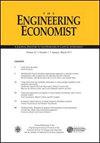Cash holding management for self-financing phase-able and non-phase-able project portfolio selection and scheduling problems
IF 1.2
4区 经济学
Q4 BUSINESS
引用次数: 0
Abstract
Abstract This article presents a novel mathematical model for managing the level of cash reserves for the self-financing phase-able as well as non-phase-able project portfolio selection and scheduling problems. Practically, the executive managers of project-oriented organizations tend to keep cash within their organization to increase their decision-making power. Although this allows managers and investors to invest in future economic projects, it imposes opportunity costs on owners and investors, in which case maintaining cash reserves can turn out to be a major challenge between owners and executive managers. This issue becomes more acute when the project-based organization operates self-financing. Because the financing is limited to the revenues of the finished projects, money withdrawn from the project account without proper management exacerbates financial constraints. Consequently, managers will bypass some future valuable investment opportunities. In this article, from the point of view of cash holding, the expectations of managers and investors in a self-financing phase-able and non-phase-able project-based organization will be met simultaneously. The proposed model is a nonlinear integer program. After linearization, an example is provided to illustrate the applicability and performance of the proposed model.自筹资金阶段性和非阶段性项目组合选择和调度问题的现金持有管理
摘要本文提出了一个新的数学模型,用于管理自筹资金的阶段性和非阶段性项目组合选择和调度问题的现金储备水平。实际上,项目导向型组织的执行经理倾向于在组织内保留现金,以增加他们的决策权。尽管这允许管理者和投资者投资于未来的经济项目,但它给所有者和投资者带来了机会成本,在这种情况下,维持现金储备可能会成为所有者和执行管理者之间的一大挑战。当以项目为基础的组织自筹资金运作时,这个问题变得更加尖锐。由于融资仅限于已完成项目的收入,在没有适当管理的情况下从项目账户中提取的资金加剧了财务限制。因此,管理者将绕过一些未来有价值的投资机会。在本文中,从现金持有的角度来看,一个自筹资金的阶段性和非阶段性项目型组织的管理者和投资者的期望将同时得到满足。所提出的模型是一个非线性整数规划。线性化后,通过实例说明了该模型的适用性和性能。
本文章由计算机程序翻译,如有差异,请以英文原文为准。
求助全文
约1分钟内获得全文
求助全文
来源期刊

Engineering Economist
ENGINEERING, INDUSTRIAL-OPERATIONS RESEARCH & MANAGEMENT SCIENCE
CiteScore
2.00
自引率
0.00%
发文量
14
审稿时长
>12 weeks
期刊介绍:
The Engineering Economist is a refereed journal published jointly by the Engineering Economy Division of the American Society of Engineering Education (ASEE) and the Institute of Industrial and Systems Engineers (IISE). The journal publishes articles, case studies, surveys, and book and software reviews that represent original research, current practice, and teaching involving problems of capital investment.
The journal seeks submissions in a number of areas, including, but not limited to: capital investment analysis, financial risk management, cost estimation and accounting, cost of capital, design economics, economic decision analysis, engineering economy education, research and development, and the analysis of public policy when it is relevant to the economic investment decisions made by engineers and technology managers.
 求助内容:
求助内容: 应助结果提醒方式:
应助结果提醒方式:


